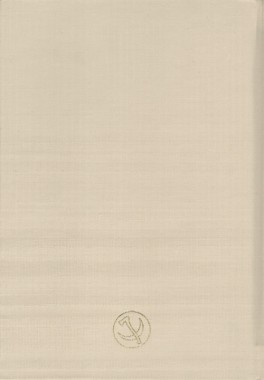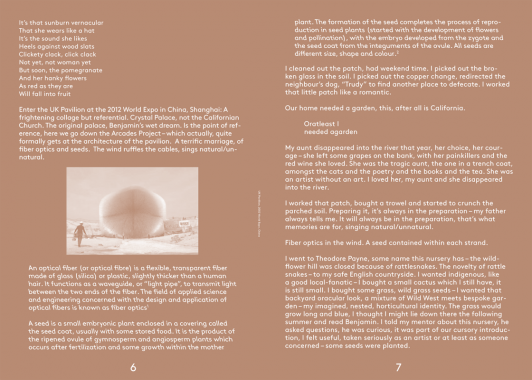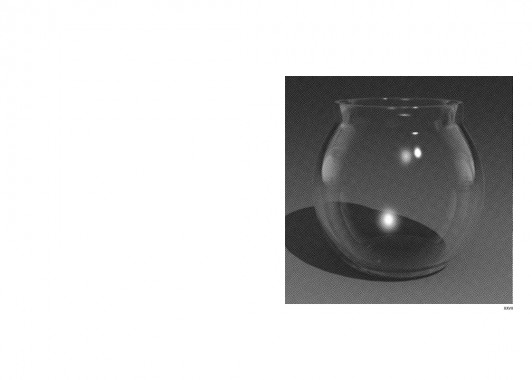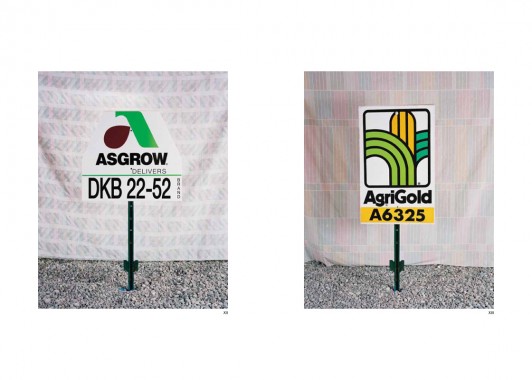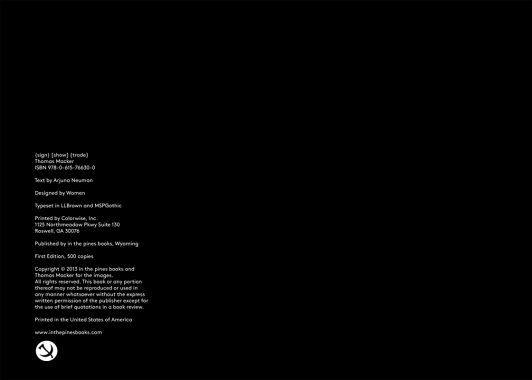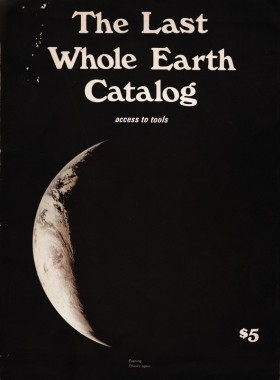SIGN SHOW TRADE
Thomas Macker, SIGN SHOW TRADE
Hardcover, 88 pp., offset 4/4, 180 x 265 mm
Edition of 500
ISBN 978-0-615-76630-0
Published by In The Pines Books
$45.00 ·
In Macker’s work, the ‘seed’ — as altered commodity — locates the collision between the idea of the natural world as something outside and other than human, and the natural world as what we are (as animals who eat food grown from seeds, eat animals who have eaten plants grown from seeds, breathe air full of oxygen created by photosynthesis, and on and on). This space of collision and contradiction is where Macker argues we reside, and the photographic and sculptural pieces that bridge the two still life series in the exhibition offer a glimpse of the effects of that lived contradiction. Dog God | Man Camp | Big Piney, WY shows a coyote impaled by a pole and posed with its head up (as if howling), a scene Macker found and documented next to one of the “Man Camps” of trailers that have sprung up throughout the Gaslands of Wyoming, the Dakotas, Colorado and Iowa to house temporary gas line workers. Another shows the snow-filled landscape where Matthew Shephard was beaten and killed, the only marker of that moment of cultural mourning and instigator of progressive action now a gas company pole. Bumper stickers Macker stole from trucks in Wyoming and printed onto vintage glass tiles depict bikini-clad women alongside text that reads ‘Just Frack It’, and, a digitally rendered bust of a disembodied pregnant torso hangs next to a digitally rendered image of a Molatov cocktail. Reproduction, destruction, re-birth, identity, and verbal and physical languages of dominance comingle with cultural hope and yearning — a yearning that always seems to leave violence in its wake.
In the second still life series, the seed signs have been replaced by gas company signage. These signs, stolen by Macker during drives across the Gaslands, functioned as markers for the temporary roadways that crisscross the landscape where gas lines are in construction. In this series, the signs rest on top of a wooden crate instead of being placed in gravel, and the backdrop is now constructed of brown carpet. In front of the carpet, Macker has hung reproductions of 19th and 20th century artwork mythologizing woodcutters. Behind a Unit Drilling Company sign directing us towards Rig 24, we see Winslow Homer’s The Woodcutter, here featured on a living room wall as part of an interior design advertisement. In Der Holzfäller, Ferdinand Hodler, 1910, a Danger Benzene Cancer Hazard sign accompanied by a potted plant stands in front of Ferdinand Hodler’s Der Holzfäller. Co-opting these already-reproduced artworks, Macker highlights the historic glorification of human dominance over nature, as well as the problematic placement of the artist within this glorification, as a symbol and actor of these same problematic humanist ideals. The scenes are constructed to be visually satisfying, uncomfortable, humorous, claustrophobic, and unexpectedly personal, reflecting our continued desire to feel communal pride in our accomplishments, as well as the consequences of a system in which the structure for expansion we have created necessitates an unwillingness to recognize the fallibility or responsibility of power.
The Last Whole Earth Catalog
Stewart Brand, The Last Whole Earth Catalog
Softcover, 452 pp., web offset 1/1, 10.75 x 14.25 inches
First edition (1971)
ISBN 0-394-70459-20
Published by Portola Institute
$55.00 · out of stock
We can’t put it together. It is together.
The Whole Earth Catalog is an American counterculture catalog published by Stewart Brand between 1968 and 1972, and occasionally thereafter, until 1998. Although the WECs listed all sorts of products for sale (clothing, books, tools, machines, seeds — things useful for a creative or self-sustainable lifestyle), the Whole Earth Catalogs themselves did not sell any of the products. Instead the vendors and their prices were listed right alongside with the items.
The title Whole Earth Catalog came from a previous project of Stewart Brand. In 1966, he initiated a public campaign to have NASA release the then-rumored satellite photo of the sphere of Earth as seen from space, the first image of the “Whole Earth.” He thought the image might be a powerful symbol, evoking a sense of shared destiny and adaptive strategies from people. The Stanford-educated Brand, a biologist with strong artistic and social interests, believed that there was a groundswell of commitment to thoroughly renovating American industrial society along ecologically and socially just lines, whatever they might prove to be.
Function
The Whole Earth Catalog functions as an evaluation and access device. With it, the user should know better what is worth getting and where and how to do the getting. An item is listed in the Catalog if it is deemed:
1. Useful as a tool
2. Relevant to independent education
3. High quality or low cost
4. Not already common knowledge
5. Easily available by mail
Catalog listings are continually revised according to the experience and suggestions of Catalog users and staff.
Purpose
We are as gods and might as well get good at it. So far, remotely done power and glory — as via government, big business, formal education, church — has succeeded to the point where gross defects obscure actual gains. In response to this dilemma and to these gains a realm of intimate, personal power is developing — power of the individual to conduct his own education, find his own inspiration, shape his own environment, and share his adventure with whoever is interested. Tools that aid this process are sought and promoted by The Whole Earth Catalog.

